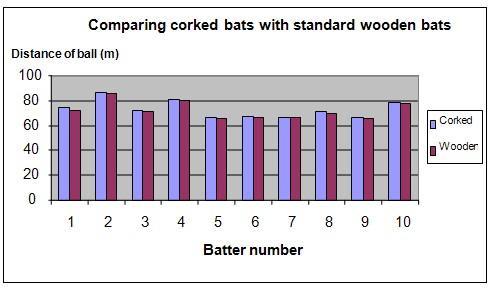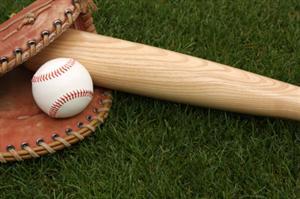| Complexity level: | 9 |
| Project cost ($): | 80 |
| Time required: | 1 hour to prepare, 1 day for the science project experiment |
| Material availability: | Easily found |
| Safety concerns: | Sports safety rules should be followed. The experiment should be supervised by an adult. |
Hypothesis
A baseball will travel further when hit with a corked baseball bat, rather than a standard wooden bat.
Overview
Baseball bats
Baseball bats are normally made from wood or aluminum. Wooden bats break easily and when they do so, they splinter. Wooden bats are also heavier but as a result, the ball travels further when hit with a wooden bat. A fast swing and a hard bat will cause the ball to travel faster and further. The wooden bat’s center of gravity is farther away from the hand and therefore it feels heavier when held.
Corked bats are made by drilling a hole through the core of the bat and filling it with a less dense material like cork. This will make the bat slightly lighter while maintaining its power. The lighter bat enables the player to have better control over timing and produces a faster swing.
Lowering the mass of the bat may increase the speed of the swing, but the impact between the ball and the bat becomes less effective. At the same swing speed, the heavier bat will enable the ball to travel further and faster.
A bat that is swung more quickly will cause the ball to travel faster and a lighter bat with a less effective "collision" between ball and bat, will produce a slower ball. This may mean that there is little or no advantage in using a corked bat.
Scientific Terms
Materials
The materials required for this science fair project:
- 10 baseball batters
- 1 baseball pitcher
- 1 wooden baseball bat
- 1 corked baseball bat
- 2 dozen baseball balls
- Measurement tape
- 1 assistant
Procedure
1. For this science fair project, the independent variable is the use of a corked bat or standard wooden bat. The dependent variable is the distance traveled by the ball. This is determined by measuring the distance with the measuring tape. The constants (control variables) are the skill of the batter, the skill of the pitcher and the type of baseball used.
2. The baseball batters are each assigned a number between 1 and 10 and they are asked to prepare for the science fair project by warming up.
3. The first batter is asked to get ready to hit the ball using the corked bat. The pitcher will throw the ball and the batter swings the bat to hit it. The distance traveled by the ball is measured by the assistant, using the measuring tape. The batter will hit the ball 3 times with the same bat and the farthest distance travelled by the ball is measured and recorded.
4. The same batter is next requested to hit the ball up to 3 times using the standard wooden bat. The farthest distance traveled by the ball is measured and recorded in the table below.
5. Procedures 3 and 4 are repeated with the remaining 9 batters. The distance traveled by the ball after every hit is measured . The furthest distance traveled by the ball is recorded in the table given below.

Results
The results showed that the ball traveled slightly further after being hit with the corked bat, compared to the distance produced with the wooden bat.
|
Bat type |
Average distance traveled by the ball (meters) |
|||||||||
|
1 |
2 |
3 |
4 |
5 |
6 |
7 |
8 |
9 |
10 |
|
|
Corked bat |
73.7 |
86.3 |
72.4 |
80.4 |
66.3 |
67.3 |
66.6 |
70.7 |
66.5 |
78.4 |
|
Wooden bat |
72.4 |
85.7 |
71.2 |
79.8 |
65.7 |
65.9 |
66.3 |
69.2 |
65.3 |
77.9 |
The chart below represents the results of our science project experiment.

Conclusion
Our hypothesis has been proven to be true. A baseball will travel further when hit with a corked baseball bat, rather than a standard wooden bat..
Using a modified bat in Major League Baseball is illegal and players can get punished or suspended for using them. In the last 40 years, several players have been caught using corked bats. Corked bats tend to break easily and this was how most of the players get caught. Moreover, the improvement in the ball travel distance is very minimal, at most, only a few extra feet.
Also consider
To improve the reliability and accuracy of our results, a larger sample of participating baseballers should be used.
This science fair project may be repeated, this time, comparing a a lighter wooden bat with a corked bat.
Modify the science project experiment, to measure the speed of the ball produced by different bats.
References
Aluminum bats vs wooden bats - http://en.wikipedia.org/wiki/Aluminum_Bats_vs._Wood_Bats
Corked bat - http://en.wikipedia.org/wiki/Corked_bat
What about corked bats - http://paws.kettering.edu/~drussell/bats-new/corkedbat.html

